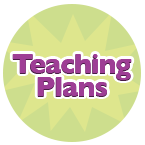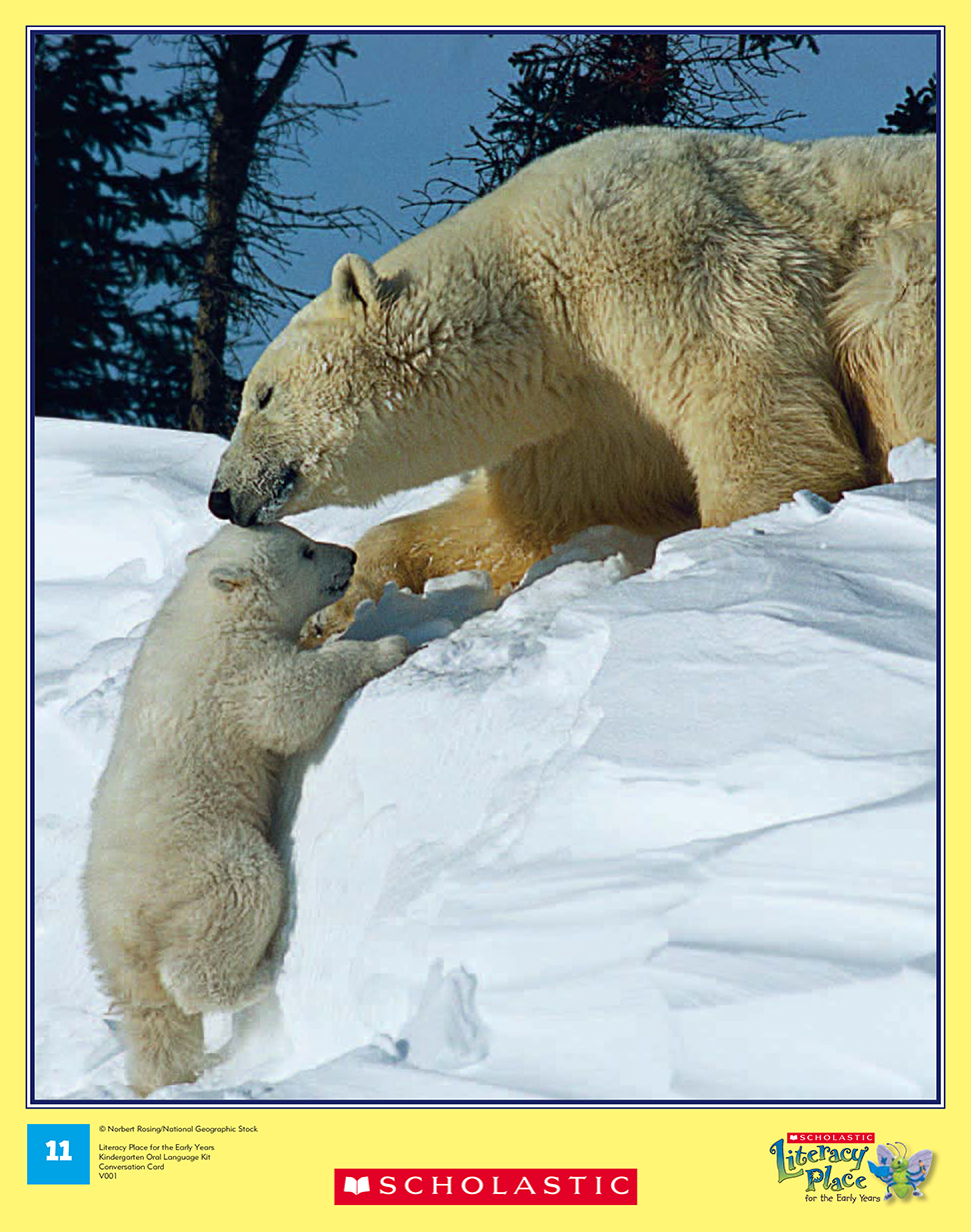Oral Language Teaching Strategy:
Model Good Language Use Clarify and model good language use, without correcting, when individuals need support.
Time: one 30-minute lesson or two 15-minute lessons
Materials: Emotions/Interactions Conversation Card #11
Grouping: whole class or small group
Assessment: Kindergarten Oral Language Assessment Scale
FOCUSING ON THE PICTURE
[Analyzing/inferring]What do you see in the picture? What do you think is happening? How do you think the polar bears are feeling? Why?
Show students the picture. Give students some time to really look at the picture. Provide prompts if necessary.
- Invite students to share their ideas about the picture with a partner.
Gabriel you said, “The mother talks to her baby,” so let’s write that down. (Write: ‘The mother talks to her baby’). Does that look and sound right? We have one idea, let’s add some more. Who else has an idea?
Have a few of the students to share their thinking with the larger group. Record ideas on sentence strips and support students in using correct language structures when necessary. After you write each sentence have students reread the sentence as you point to each word. Record at least 5 ideas, modelling correct language structure when needed.
[Analyzing/inferring]
- Offer prompts to stimulate the discussion and ideas:
- What do you think is happening with the baby bear? Why do you think this?
- What clues can we use to figure out what is happening in this picture?
- What will the mother polar bear do next?
- What would you do if you were the mother?
GOING DEEPER
[Inferring/evaluating]- Offer prompts that focus the students on the emotions and interaction portrayed in the picture:
- How do you think the polar bear cub is feeling? What clues tell you this?
- How do you think the mother polar bear is feeling? Why?
- How do you think the polar bears got themselves in this situation?
-
Milania, you said “What does it eat?” Would you like to know what they, the polar bear, eat? Can someone answer this question for Milania?
Have students turn to a partner to discuss these prompts. Have each pair decide on one question they want to ask about the picture. Have them share this question with the group and have the other students answer the question using the clues provided in the picture.
Teaching Tip: Rephrasing a student comment is a positive way to model appropriate language structures and demonstrate that you are really listening to what a student is saying.
You may conclude the lesson at this point and do the second part on the next day, or you may decide to continue and do Connecting and Predicting as part of the first lesson.
CONNECTING
Teaching Tip: If you decide to do Connecting and Predicting on the second day, begin your lesson by reviewing the picture with the students.
[Making connections]- Ask students to connect their personal experiences with the emotions and interactions in the picture. Prompts might include:
- In this picture, a mother polar bear and her cub are shown. Let’s brainstorm everything we know about polar bears.
- In this picture a mother polar bear is trying to help her baby and comfort it. Has this ever happened to you? What happened? How did your mom or dad help you? How did this make you feel?
- Have you ever felt lost? Who helped you?
Have you ever felt lost and frightened? What did you do?
Offer specific prompts that fit the discussion you have had with the group.
PREDICTING
[Predicting]What do you think will happen next? Why do you think this?
Ask students to think about what might happen next in this picture.
- Brainstorm possible scenarios with students. Make sure to ask students why they think this will happen, ensuring they are building on the picture and discussions that have taken place. Remember to model correct language structures if students give you answers that are grammatically incorrect.
- Ask students to think about what happened before and after this picture was taken. Have them share their thoughts with a partner. Then call on groups to share their ideas in sequence. Have one group share their ‘before’ ideas then hold up the picture for the ‘during.’ Finally call on another group to share their ‘after’ ideas.
LESSON EXTENSIONS
- Gather a collection of books on polar bears to read to the class as read aloud texts. As the class learns new information about polar bears, add it to a chart called ‘What We Learned about Polar Bears.’ Some great read aloud books for Kindergarten are:
- Polar Bears by Jacqueline S. Cotton
- Polar Bear Alert by Debora Pearson
- Once I was a Cardboard Box But Now I’m a Book About Polar Bears by Anton Poitier
- How One Little Polar Bear Captivated the World by Craig Hatkoff
- Create a class big book about polar bears using the ‘What We Learned about Polar Bears’ chart. Have each student choose a fact they want to illustrate for the book. When a student tells you a fact, be sure to clarify and model good language use. Help students to label their illustrations. When each page is complete, collate, and share the new book with the class.
FOLLOW-UP IN CENTRES
- Place the class big book about polar bears along with other books about polar bears in the reading centre for students to peruse and read during centre time. Some great fiction stories to add to the collection are:
- Polar Bear, Polar Bear, What Do You Hear? by Bill Martin Jr.
- Little Polar Bear (series) by Hans de Beer
- The Three Snow Bears by Jan Brett
- Have supplies and cutouts available for students to make polar bear masks at the art centre. Once students have made the masks, they can act out the picture. This strengthens their thinking about what they think has happened in the picture and allows them time to incorporate the ideas they have heard from their peers.
- Display the picture at the science centre for students to record their ideas about the photo on sticky notes. Have students stick the notes on the picture or provide sentence strips for students to write facts they have learned. These sentence strips can be placed around the picture of a polar bear. Remind students that the writing can be reread when going on a ‘reading walk’ around the room during centre time.
- Display the picture at the art centre. Have students create a painting or drawing to show a before or after scene for the picture.

